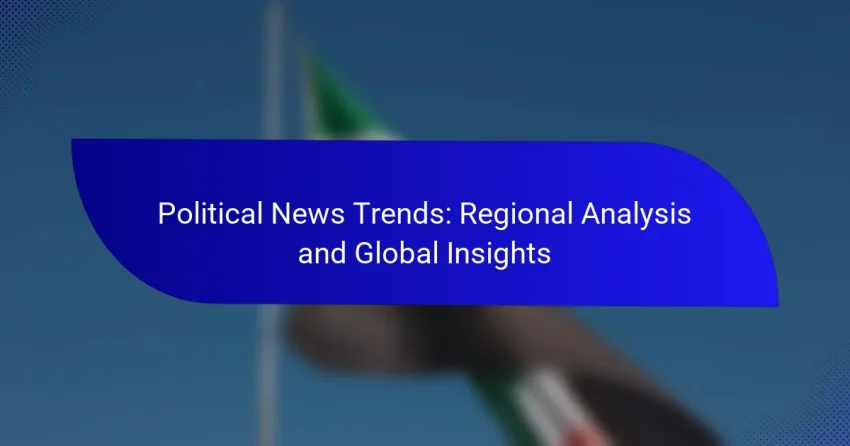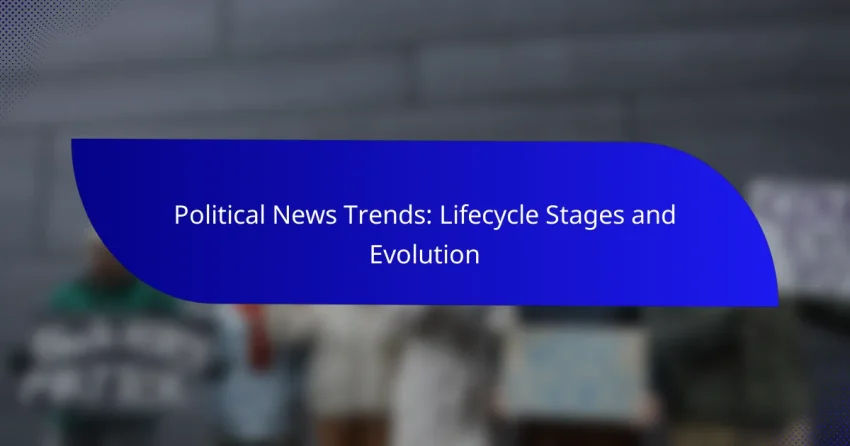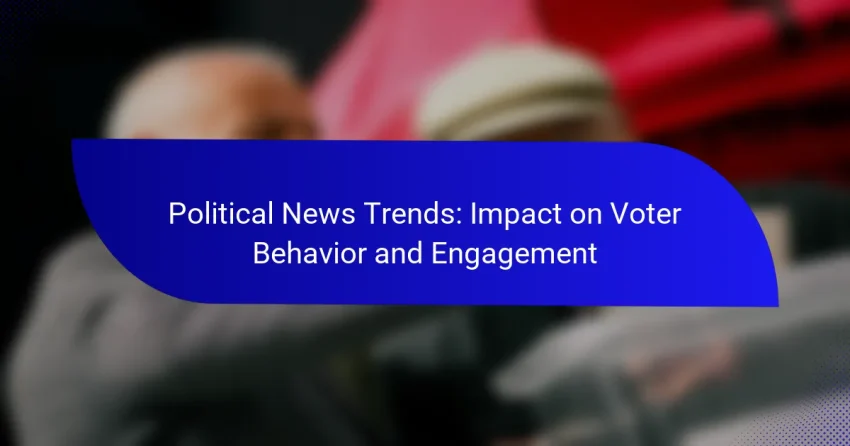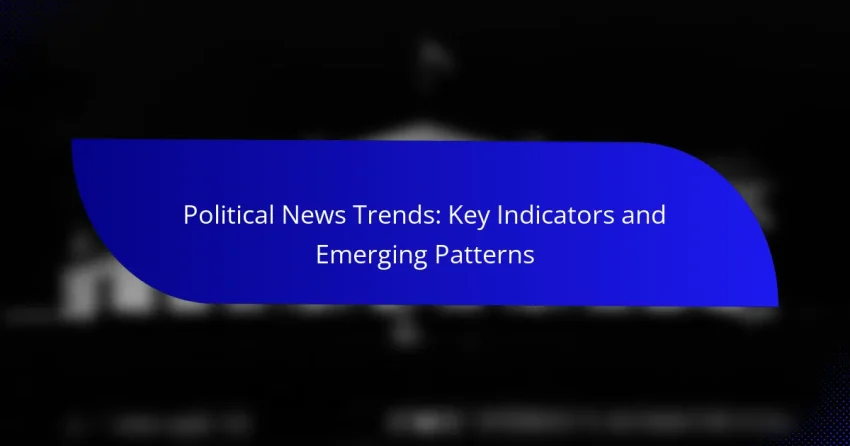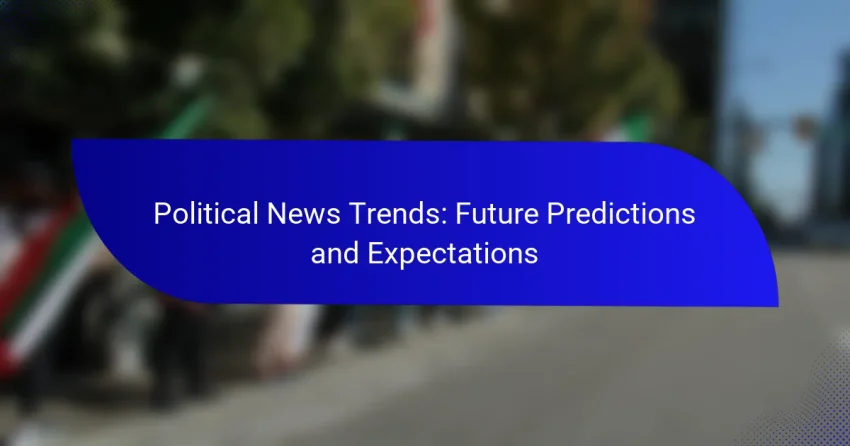The landscape of political news is evolving rapidly across various regions, with distinct trends emerging that reflect local and global dynamics. In North America, a focus on climate policy and the rise of populism are reshaping electoral politics, while Europe grapples with shifting party dynamics and public sentiment. Meanwhile, Asia’s diverse political environments and economic…
Category: Political News Trends
Current political news trends in the US reveal important shifts in policy focus, media influence, and public engagement. Topics such as climate change initiatives, social media’s role in elections, and the growing polarization of political discussions are at the forefront of public discourse, significantly impacting voter behavior and perceptions.
Political News Trends: Lifecycle Stages and Evolution
Political news trends are constantly evolving, influenced by public interest, media coverage, and significant societal events. Key issues such as climate change and populism shape these narratives, while the role of social media accelerates their dissemination. By examining the lifecycle stages of political news, we can better understand how stories develop, gain traction, and eventually…
Political News Trends: Impact on Voter Behavior and Engagement
Political news trends play a critical role in shaping voter behavior and engagement, influencing how individuals consume information and prioritize issues. As the landscape of news coverage evolves, it can lead to heightened electoral participation and a shift in voter focus toward specific topics. Understanding these trends is essential for stakeholders aiming to navigate the…
Political News Trends: Key Indicators and Emerging Patterns
Political news trends are shaped by key indicators such as public opinion polls, election outcomes, and legislative changes, which collectively offer insights into voter behavior and the political landscape. As emerging patterns evolve, they significantly impact campaign strategies and voter engagement, necessitating adaptability from political entities. Furthermore, the role of social media in shaping public…
Political News Trends: Tools for Tracking and Engagement
In today’s fast-paced political landscape, utilizing the right tools to track news trends is essential for staying informed and engaged. Platforms that aggregate data and analyze public sentiment can provide valuable insights into emerging topics and political dynamics. By leveraging social media and other engagement tools, individuals can enhance their understanding and influence within the…
Political News Trends: Influence on Public Opinion and Perception
Political news trends play a crucial role in shaping public opinion by framing issues and guiding perceptions. In 2023, the rise of fact-checking initiatives, a focus on local news, and the emergence of alternative media sources are significantly influencing how individuals interpret political events. Understanding the varied responses across different demographics is essential for effectively…
Political News Trends: Future Predictions and Expectations
As we approach 2024, political news trends are poised to significantly influence global discourse, focusing on critical issues such as climate policy, populism, and the impact of social media. The evolution of political coverage will be driven by technological advancements and changing audience preferences, leading to a rise in data-driven journalism and independent news platforms….
What Are the Current Political News Trends in the US?
Current political news trends in the US highlight significant shifts in policy focus, media influence, and public engagement. Key areas of interest include climate change initiatives, the impact of social media on elections, and the increasing polarization of political discussions.
Increased focus on climate change policies
Climate change policies are becoming a central theme in US political discourse, driven by growing public concern and scientific evidence. Many states are implementing ambitious goals for reducing greenhouse gas emissions and transitioning to renewable energy sources.
Legislators are increasingly prioritizing investments in clean energy technology and infrastructure. For example, the Inflation Reduction Act has allocated substantial funding for renewable energy projects, aiming to incentivize both businesses and consumers to adopt sustainable practices.
Rise of social media influence on elections
Social media is playing an increasingly pivotal role in shaping electoral outcomes in the US. Platforms like Twitter, Facebook, and Instagram allow candidates to directly communicate with voters, often bypassing traditional media channels.
However, this influence comes with challenges, including the spread of misinformation and the potential for echo chambers. Candidates need to develop effective social media strategies that engage voters while ensuring the accuracy of their messaging.
Growing polarization in political discourse
Political discourse in the US is becoming more polarized, with individuals increasingly aligning with extreme viewpoints. This trend is evident in both public opinion and legislative processes, where compromise is often difficult to achieve.
To navigate this environment, it is essential for politicians and voters alike to engage in constructive dialogue and seek common ground. Understanding differing perspectives can help mitigate the divisive nature of current political discussions.
Shift towards local governance issues
There is a noticeable shift towards local governance issues as communities seek to address challenges that directly affect their residents. Topics such as housing, education, and public safety are gaining prominence in local elections.
Voters are increasingly prioritizing candidates who focus on grassroots initiatives and community engagement. This trend encourages local leaders to be more responsive to the needs of their constituents, fostering a sense of accountability.
Emergence of new political movements
New political movements are emerging in response to changing social dynamics and public sentiment. Groups advocating for issues like social justice, environmental sustainability, and economic reform are gaining traction and influencing mainstream politics.
These movements often leverage grassroots organizing and digital platforms to mobilize support. Understanding their goals and strategies can provide insights into the evolving landscape of US politics and the issues that resonate with younger voters.
How Do Political News Trends Affect Voter Behavior?
Political news trends significantly influence voter behavior by shaping perceptions and priorities. As voters consume news, their understanding of candidates and issues evolves, which can lead to changes in turnout, party loyalty, and the importance placed on specific topics.
Influence on voter turnout
Political news trends can either motivate or discourage voter turnout. For instance, heightened coverage of an election can energize voters, particularly among younger demographics, leading to increased participation. Conversely, negative news cycles may lead to apathy, causing potential voters to feel disillusioned and less likely to engage.
To enhance turnout, campaigns often leverage trending news to create urgency. For example, emphasizing key issues in the media can mobilize supporters who feel strongly about those topics.
Shifts in party allegiance
Voter allegiance can shift dramatically in response to political news trends. When a party is portrayed positively in the media, it may attract undecided voters or those previously loyal to other parties. Key events, such as debates or scandals, can significantly alter public perception and party loyalty.
For instance, a major news story highlighting a party’s successful policy implementation can lead to increased support among swing voters. Campaigns should monitor media narratives closely to adapt their strategies accordingly.
Impact on issue prioritization
Political news trends heavily influence which issues voters prioritize. As certain topics gain traction in the media, voters may begin to view them as more critical, impacting their decision-making process. For example, if climate change receives extensive coverage, it may rise to the top of voters’ concerns.
Campaigns can capitalize on this by aligning their messaging with trending issues. Understanding the current media landscape allows candidates to address the most pressing concerns of their constituents effectively.
What Are the Key Platforms for Political News?
Key platforms for political news include traditional media outlets like CNN and Fox News, as well as social media channels such as Twitter and Facebook. Each platform plays a distinct role in shaping public perception and discourse around political events.
CNN as a leading source
CNN is recognized as a major source of political news, providing comprehensive coverage of national and international events. Its reporting often includes live updates, expert analysis, and in-depth investigations, making it a go-to for many viewers seeking reliable information.
Viewers appreciate CNN for its commitment to journalistic standards, though it has faced criticism for perceived biases. Understanding its editorial stance can help audiences better interpret the news presented.
Fox News’ role in shaping narratives
Fox News plays a significant role in shaping political narratives, particularly among conservative audiences. Its programming often emphasizes viewpoints that resonate with right-leaning viewers, influencing public opinion and voter behavior.
Fox News’ approach includes a mix of news reporting and opinion segments, which can blur the lines between information and commentary. This duality is crucial for audiences to recognize, as it affects how news is consumed and understood.
Social media platforms like Twitter and Facebook
Social media platforms such as Twitter and Facebook have transformed the landscape of political news by enabling rapid information sharing and direct engagement between politicians and the public. These platforms facilitate real-time updates and discussions, making them essential for staying informed.
However, the unfiltered nature of social media can lead to the spread of misinformation. Users should critically evaluate sources and verify information before sharing, as the viral nature of content can amplify inaccuracies.
How Is Data Analytics Used in Political Reporting?
Data analytics plays a crucial role in political reporting by providing insights into voter behavior and preferences. Journalists leverage data to inform their narratives, enhance accuracy, and predict electoral outcomes.
Voter data analysis for targeted messaging
Voter data analysis involves examining demographic information, past voting behavior, and preferences to craft tailored messages. Political campaigns often segment voters into groups based on characteristics such as age, income, and location to maximize engagement.
For example, a campaign might focus on environmental issues for younger voters while emphasizing economic growth for older demographics. This targeted approach can significantly increase the effectiveness of campaign communications.
Use of polls and surveys for trend prediction
Polls and surveys are essential tools in political reporting, allowing analysts to gauge public opinion and predict trends. By collecting data from a representative sample, campaigns can understand voter sentiment on key issues and adjust strategies accordingly.
Common pitfalls include over-reliance on a single poll or failing to account for margin of error, which can lead to misinterpretation of public sentiment. It’s advisable to look at multiple sources and trends over time for a more accurate picture of voter intentions.
What Are the Challenges in Political News Reporting?
Political news reporting faces several significant challenges, including the spread of misinformation, the need to maintain journalistic integrity, and the pressure to keep up with fast-paced news cycles. Each of these factors can impact the quality and reliability of news coverage.
Combatting misinformation
Misinformation poses a major challenge in political news reporting, as false narratives can quickly spread through social media and other platforms. Journalists must verify facts rigorously and rely on credible sources to counteract misleading information.
To combat misinformation effectively, news organizations can implement fact-checking protocols and collaborate with independent fact-checkers. Training reporters on identifying and addressing false claims is also essential for maintaining public trust.
Maintaining journalistic integrity
Maintaining journalistic integrity is crucial for political news outlets to ensure their credibility. This involves adhering to ethical standards, such as accuracy, fairness, and transparency in reporting.
Journalists should disclose conflicts of interest and avoid sensationalism to uphold their integrity. Regular training on ethical journalism practices can help reporters navigate complex political landscapes while remaining impartial.
Adapting to fast-paced news cycles
The fast-paced nature of political news requires reporters to be agile and responsive. News can break at any moment, necessitating quick analysis and reporting to keep the public informed.
To adapt, journalists should prioritize their tasks and use technology to streamline their workflows. Developing a network of reliable sources can also help reporters gather information rapidly and accurately, ensuring timely coverage without sacrificing quality.
How Do Political News Trends Vary Globally?
Political news trends differ significantly across the globe, influenced by cultural, economic, and governmental factors. In democratic nations, news tends to focus on transparency and accountability, while in authoritarian regimes, reporting may be heavily controlled and censored.
Comparative analysis of political trends in Europe
In Europe, political news trends often reflect the diverse political landscapes of the region. Western European countries generally have robust media freedom, allowing for a wide range of political discourse. In contrast, Eastern European nations may experience varying degrees of media restrictions, with some countries facing significant challenges to journalistic independence.
For example, countries like Sweden and Germany prioritize investigative journalism and public accountability, while Hungary has seen a rise in government influence over media outlets. This divergence impacts how political events are reported and perceived by the public.
Impact of authoritarian regimes on news reporting
Authoritarian regimes typically impose strict controls on news reporting, limiting journalists’ ability to cover political events freely. In these environments, state-run media often dominate, shaping narratives that align with government interests and suppressing dissenting voices.
Countries such as North Korea and Belarus exemplify this trend, where independent journalism is virtually nonexistent, and the government dictates the news agenda. This results in a lack of reliable information for citizens, who may rely on alternative sources, including social media and foreign news outlets, to understand political developments.
